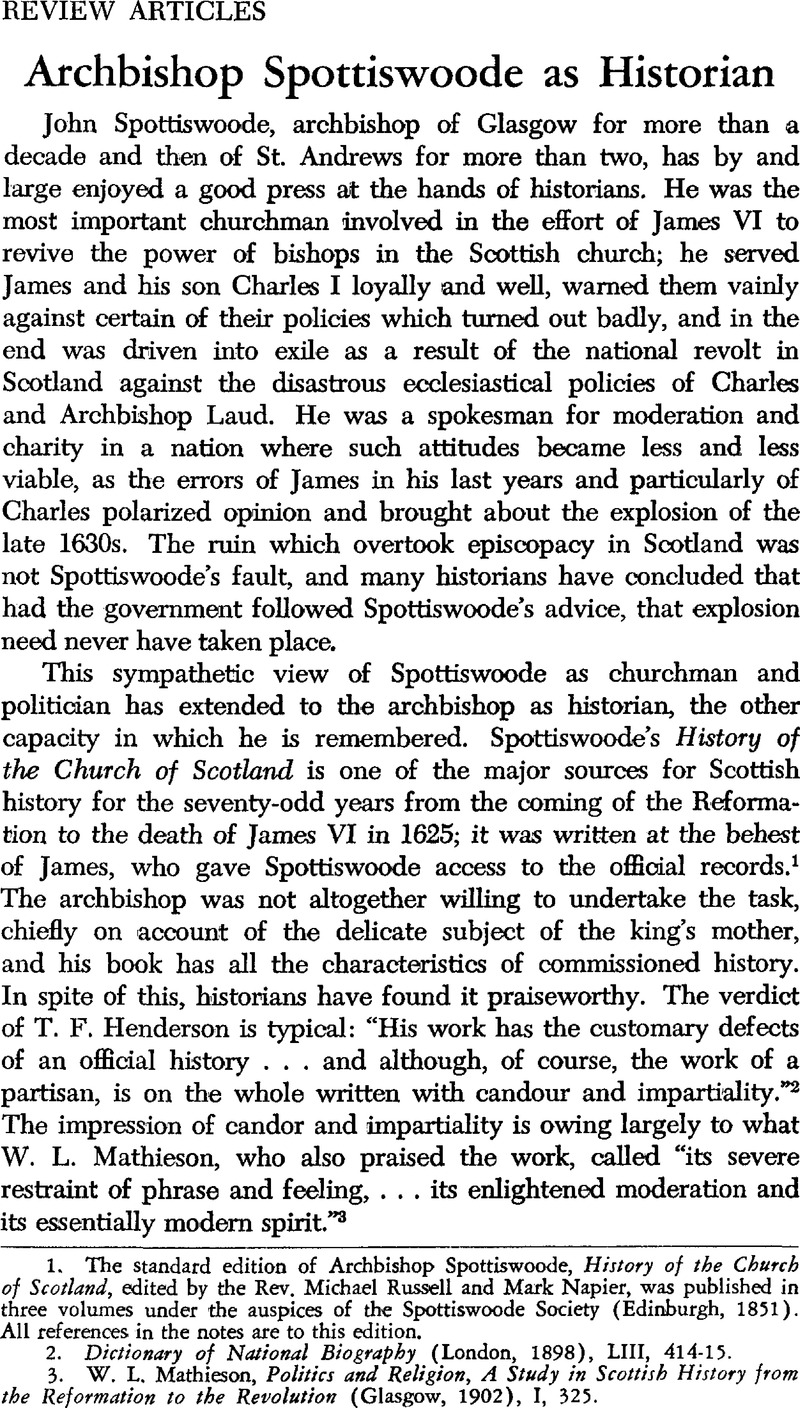No CrossRef data available.
Published online by Cambridge University Press: 16 January 2014

1. The standard edition of Spottiswoode, Archbishop, History of the Church of Scotland, edited by the Rev.Russell, Michael and Napier, Mark, was published in three volumes under the auspices of the Spottiswoode Society (Edinburgh, 1851)Google Scholar. All references in the notes are to this edition.
2. Dictionary of National Biography (London, 1898), LIII, 414–15Google Scholar.
3. Mathieson, W. L., Politics and Religion, A Study in Scottish History from the Reformation to the Revolution (Glasgow, 1902), I, 325Google Scholar.
4. Spottiswoode, , History, II, 27, 35Google Scholar. Dickinson, W. C. (ed.), John Knox's History of the Reformation in Scotland (New York, 1950), I, 112Google Scholar.
5. Spottiswoode, , History, III, 247Google Scholar. Calderwood , D., The History of the Kirk of Scotland, ed. Thomson, Thomas [Wodrow Society] (Edinburgh, 1842–1849), VII, 395Google Scholar.
6. Spottiswoode, , History, II, 82Google Scholar.
7. Ibid., p. 121.
8. Ibid., p. 7.
9. Ibid., p. 62. George Buchanan was a famous humanist turned Protestant propagandist, who became tutor to the young James VI.
10. Ibid., p. 361.
11. Ibid., I, 373.
12. Ibid., II, 184.
13. See for instance, Donaldson, Gordon, The Scottish Reformation (Cambridge, 1960)Google Scholar, chap. 5.
14. Spottiswoode, , History, I, xxiiiGoogle Scholar. Spottiswoode very nearly fulfilled his original intention at that; over three-fourths of his text deals with events between 1558 and 1625.
15. Ibid., pp. cxxxvii-cxxxviii.
16. See, for instance, the argument, ibid. II, 272-73, that the abolition of episcopacy would have very adverse effects on the material welfare of the remaining ministers, because the temporalities of the bishoprics would be swallowed up by laymen, as those of the monasteries had been.
17. Ibid., I, 327, 373; II, 15, 282, 376-77; III, 227. Robert Montgomerie held the archbishopric of Glasgow briefly in the 1580s as a result of a corrupt transaction with King James's favorite, Esmé Stewart, duke of Lennox. George Gledstanes was archbishop of St. Andrews from 1604 to 1615. The 1587 Act of Annexation of the temporalities of benefices to the crown was repealed in 1606.
18. Ibid., II, 336-37.
19. Calderwood, , History, VI, 2Google Scholar.
20. Spottiswoode, , History, III, 270Google Scholar.
21. See his critical comments on the compromise of 1586 which was to contribute to the triumph of presbyterianism in 1592; ibid., II, 341-42.
22. As one example among many, see the exchange between the young king and the General Assembly in October 1583, ibid., pp. 303-05.
23. The Raid of Ruthven, a coup d'état engineered in 1582 by the Protestant faction of the Scottish aristocracy with the wholehearted support of the dominant element among the clergy, put an end to the influence of James's French cousin and favorite, Lennox.
24. Spottiswoode, , History, II. 343Google Scholar. It should be pointed out, however, that in the most spectacular confrontation between king and ministers, that which led to the riot of December 1596, Spottiswoode lays much of the blame on a court clique which deliberately misled both sides in an attempt to pull down the group of officials known as the Octavians. Ibid., III, 8 ff, esp. p. 27.
25. Ibid., II, 373; III, 230, 250. Patrick, Master of Gray, played a sinister role in the negotiations preceding the execution of Mary Queen of Scots. Frances Howard, countess of Somerset, was the central figure in the famous Overbury poisoning case. The five articles of Perth, imposed on the Scottish church by King James in 1618, were regarded as Popish by the majority of the Scottish clergy.
26. See Mathieson, , Politics and Religion, I, 316-20, 324Google Scholar. Compare Spottiswoode's, account, History, III, 241–57Google Scholar.
27. Calderwood, , History, VII, 421Google Scholar.
28. Spottiswoode, , History, I, 301–02Google Scholar.
29. Ibid., p. 321.
30. Ibid., II, 184-85. See also I, 320-21.
31. Ibid., II, 300. James's dislike of Buchanan's political views was notorious.
32. Ibid., III, 225.
33. Ibid., p. 227. Ogilvie was the only Scottish Jesuit martyr.
34. Ibid., p. 205. James Elphinstone, Lord Balmerino, was Secretary of State from 1598 until his fall in 1609. It seems likely that he made his confession largely to allow the king to save face.
35. Ibid., II, 200.
36. Ibid., II, 200-03, 257, 308-09, 416-17, 448; III, 65. Francis Stewart, earl of Bothwell, nephew of Queen Mary's Bothwell, kept Scotland in turmoil in the early 1590s. He posed as a champion of Protestantism, and received support from those ministers who thought James was too lenient with Catholics in general and George Gordon, earl of Huntly, in particular.
37. Ibid., II, 258-59. Cf. McCrie, Thomas, Life of Andrew Melville (2nd ed., Edinburgh, 1824), I, 84–85Google Scholar. McCrie has noted a number of other inaccuracies in Spottiswoode's account of Melville.
38. Spottiswoode, , History, III, 82Google Scholar. For the Montrose Assembly cf. the much fuller account in Calderwood, , History, VI, 1–26Google Scholar; see also Mathieson, , Politics and Religion, I, 279–80Google Scholar.
39. See, for example, March 25, 1600, Nicolson, George to SirCecil, Robert, in Mackie, J. D. (ed.), Calendar of State Papers relating to Scotland and Mary Queen of Scots, XIII (Edinburgh, 1969), 629–30Google Scholar.
40. Spottiswoode, , History, I, 140-41, 165Google Scholar; II, 156. Cardinal David Beaton, the leader of the pro-French party in the late 1530s and early 1540s, was assassinated in 1 546 by men whose motives were a mixture of personal grievances, politics, and religion.
41. See, e.g., his summary of the career of Mary of Guise, ibid., I, 320.
42. Ibid., III, 6-8.
43. See, for instance, the account of Seton's role in the meeting of the illegal Aberdeen assembly of 1605, ibid., pp. 174-75.
44. Ibid., pp. 193-97. The quotation is on p. 197.
45. Ibid., p. 263.
46. Ibid., I, xxii.
47. Ibid., p. 188. Knox, , History, I, 130Google Scholar.
48. Spottiswoode, , History, I, cxxxixGoogle Scholar.